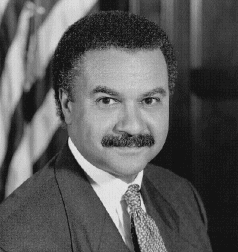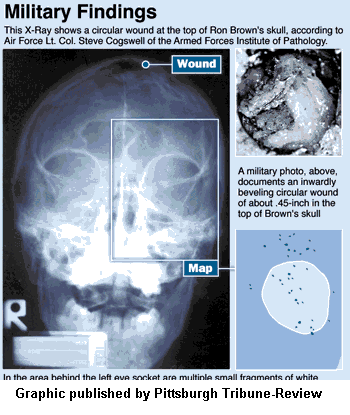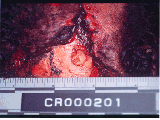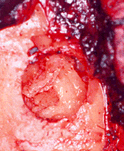|
Ron Brown Of Ron Brown, it could be argued that nothing in his life became him like leaving it.
Of Ron Brown, it could be argued that nothing in his life became him like leaving it. It's not that he wasn't an accomplished guy. But the career of a moderately accomplished politician is a small claim to lasting fame when compared to his status as the reputed target of a sinister assassination conspiracy. Brown had the kind of reasonably tough climb to the top that normally inspires respectful but tedious reflection. He was born in Harlem in 1941 to a middle-class black family, during a time when middle-class black families were pretty rare. Brown grew up as an active member of a thriving African-American community, rubbing shoulders with such the first generation of black celebrities in American, including Josephine Baker and Joe Louis. Brown joined the army in 1962, after graduating from colleges, and wisely bailed out in 1967, before the absolute worst of the Vietnam War had begun (Brown served in South Korea and Europe during his tenure). After his discharge, Brown joined the National Urban League, the leading economic equality group in the U.S., whose mission basically boils down to mainstreaming African-Americans. During Brown's tenure, League executive director Whitney Young drowned in an accident, to be replaced by burgeoning power broker Vernon Jordan in 1972. As a reasonably influential organization, it helped the reasonably industrious Brown achieve a reasonable level of visibility, which he parlayed into a reasonable career. Let's stop a moment to put this in context. Brown accomplished a lot in his life, more (on the face of it) than the author of this entry, and quite likely more than you, the reader. It's just that it was all so... bland. He was a lawyer, a lobbyist, a politico... He was smarter than average; he was articulate; by most accounts, he was nice... But he was really always just this kind of innocuous guy, part of the Washington political machine. He was a Beltway player, but not a sinister-seeming behind-the-scenes power-broker like his mentor, Jordan. Brown ended up in the better-than-average job of Commerce Secretary. Sure, it's no Secretary of State, but it's not too shabby.
All of the above considered, it's decidedly odd that Ron Brown, of all people, should be at the center of a labyrinthine political Conspiracy of gargantuan proportions, or rather, it would be if were it proven to be true (see below). As chairman of the Democratic National Committee during Bill Clinton's rise to national prominence, Brown became recognized as one of Washington's top "fixers." As fresh money flowed into Democratic Party coffers at an unprecedented rate, Brown handled the traditional quid-pro-quo that makes democracy suck so bad. He continued to act as a liaison for big-ticket donors as Commerce Secretary (one of the traditional duties of the office, actually). Perhaps because of his "nice guy" veneer, Brown was particularly tarnished by the emergence of several scandals connected to his various activities, both curricular and extracurricular. In addition to the Clinton administration's mandatory sex scandals, a number of fairly weighty accusations emerged in relation to how big Democratic Party contributors received access to the White House. Even in disrepute, Brown was above-average, rather than especially exceptional. The initial bout of allegations were pretty similar to those leveled against his predecessors. Brown had made a fortune in the early 1980s, lobbying for clients such as Haitian dictator Baby Doc. As DNC chairman in the early 1990s, he was accused of taking bribes to promote trade with Vietnam, although an FBI investigation yielded insufficient evidence to prosecute. When he became Commerce Secretary, he generally ran the place like it was the Hospitality Department of the DNC. He made a practice of bringing big money donors along on international trade missions, and hired more than a dozen former DNC shills as his administrative staff.
An independent counsel investigation was launched against Brown, but it was little noticed until early April, 1996. In the first week of April, Brown delayed his testimony in a court proceeding related to the Huang case by one week, so that he could fly to Bosnia-Croatia on a trade mission. And that's where things get really weird. The Air Force 737 carrying Brown and 34 other people went crashed into a mountain in Croatia, killing everyone on board. Enter Christopher Ruddy.
Scaife was a member of the old money Mellon family, Pittsburgh's nearest equivalent to royalty. He'd made a name for himself in the bad way by being a $1 million donor to Richard M. Nixon in 1972, a bad year for Nixon supporters. Scaife finances arch-conservative organizations around the country, and in the 1990s, he made a cottage industry out of the Clinton administration. Scaife had funded a massive investigation of the skeletons in Bill Clinton's closet, called "the Arkansas Project," of which the most visible result was a guy named David Hale—a primary witness in the Whitewater scandal, who was later revealed to have received something between small and massive cash payoffs from Scaife. Ruddy was Scaife's proudest accomplishment, if you want to call it that. A former New York Post reporter, Ruddy had been hired by Scaife as a reporter covering one all-important beat—Bill Clinton's violations of the 10 commandments, with a special focus on "thou shalt not kill" and "thou shalt not commit adultery." Ruddy had single-handedly kept the investigation of Clinton aide Vince Foster's suicide alive for years past its reasonable shelf life, persisting in claims that Foster had been murdered even after rabid Clinton-hater Ken Starr backed up the findings of two previous investigations that ruled the death a suicide. (Starr later became embroiled in a Scaife-related scandal when he suddenly quit as special prosecutor to take a job at Pepperdine University which had been funded by Scaife). Even the right-wing nuts at American Spectator magazine said in a book review that Ruddy was "a right-wing nut."
The game was afoot! And Christopher Ruddy was on the case! First, he quoted a military doctor who said that Brown's corpse had a "circular hole" in its head, consistent with a gunshot wound. As you can see from the autopsy pictures posted here, Ron Brown had more than a few holes in him. The story prompted an unlikely alliance of far-left black activists and far-right white ideologues to call for an investigation of what was initially ruled an accidental death. (The common bond between the groups was paranoia.) Ruddy's source insisted that there should have been a more detailed post mortem to determine whether a man in an airplane crash that killed 35 people had also been shot. One might think that a more committed (or at least a smarter) conspiracy theorist would focus on the actual plane crash (eventually blamed on pilot error and weather), instead of such a counterintuitive idea. After all, if you're going to crash the plane and kill everyone on board, why do the shooting too? For one thing, it's a waste of bullets. For another thing, it's a military plane, full of various armed soldiers and Commerce staffers who were surely not ALL in on the scheme and would have tried to prevent the shooting. And if there were survivors of the crash, they could testify about the shooting. And so what, did the shooter then commit suicide and crash the plane? Or did he parachute out of the plane? And if you're going to assassinate someone in a virtually lawless war zone, as Croatia was at the time, couldn't you contrive to do it in a way that wouldn't also kill 34 other people? And the plane crash HAD to be part of the plan. Because if it wasn't, then the Secretary of Commerce is just shot dead on an Air Force plane in midair. Not exactly subtle. And then what? Everyone disembarks, but no one knows anything?
The medical examiner who was the boss of Ruddy's source pointed out that the hole in Brown's head was not so much of a hole as a dent, of the sort that can be incurred by one's presence in a devastating air crash. Ruddy followed up with stories about stolen X-rays of Brown's skull, which allegedly showed some sort of metallic fragments. (Metallic fragments! In a plane crash, no less!) The autopsy photos were produced, and endlessly analyzed in the pages of the Tribune Review and by even less scrupulous conspiracy-based Web sites, which slavered with great excitement over miniscule marks which they claimed were clearly and obviously bullet fragments. Zapruder, these photos aren't. The theory advanced in the wake of all this was that Ron Brown, like Vince Foster before him, was killed because he knew something incriminating about Clinton, which he was on the verge of spilling to an eager and breathlessly waiting public. The Justice Department ruled there was no "credible evidence" to justify opening an investigation of Brown's death, while Ruddy managed to scrape up a few military people who claimed they had been told to stop asking questions. Like his career in life, Ron Brown's untimely death ultimately failed to fire up the public's imagination, despite a flurry of lawsuits and op-ed pieces from various Scaife-funded organizations, such as Judicial Watch, which continues to post a petition for a renewed investigation on its Web site to this day. But justice lovers, rest assured: As long as there is an Internet, there will be at least thousands of pages devoted to microscopic analysis of the gore, and the strange case of Ron Brown will continue to disinterest millions of people for years to come.
|
 On the other hand, can you name the last five Commerce Secretaries? The last three? The current one? Just off the top of your head, no googling, can you name one contribution any Commerce Secretary has ever made to the history of this country? Hell, go ahead and google it after all. You'll still be hard pressed.
On the other hand, can you name the last five Commerce Secretaries? The last three? The current one? Just off the top of your head, no googling, can you name one contribution any Commerce Secretary has ever made to the history of this country? Hell, go ahead and google it after all. You'll still be hard pressed.  Just before his death, Brown was scheduled to testify in a campaign finance scandal related to one of his employees, James Huang, who had been a multimillion dollar fundraiser for the Democrats before entering public service, and possibly afterward as well. As a government employee, Huang had been given access to high-level information and sat in on classified presidential briefings. He was suspected by some of funneling money from the
Just before his death, Brown was scheduled to testify in a campaign finance scandal related to one of his employees, James Huang, who had been a multimillion dollar fundraiser for the Democrats before entering public service, and possibly afterward as well. As a government employee, Huang had been given access to high-level information and sat in on classified presidential briefings. He was suspected by some of funneling money from the  Ruddy was a reporter for the miniscule Greensburg Tribune Review, a paper so weighty that it later renamed itself the Pittsburgh Tribune Review in a bid for respectability. The Tribune Review's primary journalistic distinction is that it's owned by Richard Mellon Scaife, and therein lies the beginning of a conspiracy theory.
Ruddy was a reporter for the miniscule Greensburg Tribune Review, a paper so weighty that it later renamed itself the Pittsburgh Tribune Review in a bid for respectability. The Tribune Review's primary journalistic distinction is that it's owned by Richard Mellon Scaife, and therein lies the beginning of a conspiracy theory.  By 1996, it had to be pretty clear to even die-hards like Scaife that the Vince Foster story was going nowhere, so it had to be seen as an act of providence that another member of Clinton's inner circle was dead.
By 1996, it had to be pretty clear to even die-hards like Scaife that the Vince Foster story was going nowhere, so it had to be seen as an act of providence that another member of Clinton's inner circle was dead.  The sheer pointlessness of assassinating one specific person in this way was dazzling. However, Ruddy was nothing if not compulsively determined to do things the hard way.
The sheer pointlessness of assassinating one specific person in this way was dazzling. However, Ruddy was nothing if not compulsively determined to do things the hard way.